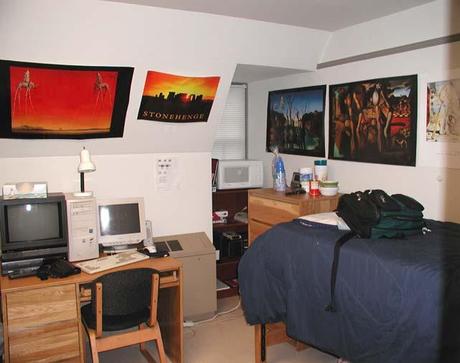
Midsummer is the time college students start preparing for fall term. With the excitement of meeting new people, finding a part-time job and worries about a robust course schedule, comes the realization that living on campus means sharing compact living quarters with a few total strangers for several months.
A typical dorm room is approximately 200 square feet — some slightly bigger, some slightly smaller. For example, a University of California single/double dorm room has 180 square feet of living space — not much room when you consider a twin size bed occupies roughly 25 square feet.
Whether you are headed to a private dorm room at the University of Texas or a room shared by four of your soon to be closest friends at BJU in South Carolina, planning an efficient, well-organized living arrangement is essential for reducing stress and managing your hectic schedule.

Photo by Raul654 via Wikimedia Commons
Seating
Choosing dorm-sized furniture that is comfortable, but trimmed down to fit in small spaces, will give you more open space. Avoid bulky oversized chairs and opt for folding chairs or bean bags that can be tossed on the bed when not in use. Don’t skimp on the desk chair. You will be spending plenty of time late at night studying.
Internet Connections
Most colleges today offer intranet and Internet access via the school network free of charge with tuition. However, according to internetserviceproviders.com, it is imperative that you have access to the fastest speed and most reliable connection in order to reduce stress and stay on top of the game. Research is more challenging with a service that slows down when traffic picks up — i.e. the middle of the night when everyone is trying to finish that midterm. A budget-friendly personal Internet service is recommended to keep you on track.
Managing Your Schedules
Keeping a well-organized clean living space is good for the body and spirit. Clutter is distracting. The Center for Disease Control reminds everyone that sterilizing surfaces cuts down on the spread of bacteria and viruses that cause flu, colds and mono.
Use a large dry erase white board or calendar, magnetic schedule board or even a homemade bulletin board to post cleaning assignments. Remember to post individual work and class schedules so no one hosts an impromptu dorm party while another roommate is trying to sleep or study for a big exam.
Lighting
Proper lighting reduces eyestrain which improves study time. Although you might not be able to change the overhead lighting, task lighting can help. Wall-mounted, swing arm lamps don’t take up valuable desk space and allow you to focus light where it is needed most. Floor lamps and wall sconces mounted at reading height also provide ample study light for times lounging in a chair or relaxing on the bed.
Drapery
While drapes are often considered a decorating feature, hanging blackout shades or drapes can be extremely beneficial. Not only do these window treatments allow you to get a restful night’s sleep, they prevent you from being distracted by activities outside the dorm room when you’re struggling to stay focused and on task.
Maintaining a clean, well-organized living space helps you stay healthy, reduces stress and makes living with strangers more enjoyable.

